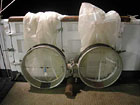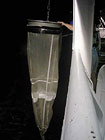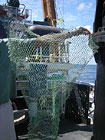

 | |||||||
|
|
Journals 2007/2008Heather Judkins
November 8, 2007 Today, I am going to discuss one of the net tows we conduct each night. One of the types of nets we tow are bongo nets. The bongo nets are a set of two, cone shaped nets designed to collect plankton from 170 m to the surface. It is deployed into the water using the J-frame winch system off the starboard side of the ship. It takes approximately 11 minutes to sink to approximately 170 m and then it is brought back to the ship. There is a flowmeter in the middle of one of the nets which records the volume of the water flowing through it. At the base of each net, there is a small cod end (small trapping netlike device) which collects the plankton during the tow. Why does it go down to 170 m? The answer is that the researchers want to get a complete profile of the upper layers of the ocean in terms of plankton diversity and biomass. These little guys are important links in the Pacific food webs in this area. Once the nets are up at the surface, they are rinsed and then brought back into the ship. The collection net is brought in to the lab where they are rinsed again and put into formalin. Then using the volume of the water that went through the nets and the volume of plankton collected, the researchers can get an idea of the biomass of plankton in this area. They go through the samples and count the various larval species and eggs in each sample for a diversity measurement. Another event that occurred today was that while marine mammal observing, we spotted a drift net in the water passing by the ship. The cruise leader decided that we should turn the ship around to pull it out of the water. Although it was relatively small, it could do great injury and possibly death if a sea turtle got trapped in it. After a few tries with the grappling hooks, the guys were successful in retrieving it! One more sea turtle saved! Marine Science Questions: 1. List two species of phytoplankton and two species of zooplankton that are found in the Gulf of Mexico. 2. What is the length of the longest drift net found in the oceans to date? (Google search) What organisms other than the turtles mentioned, could become entangled in them? |
||||||


